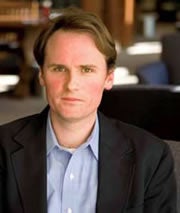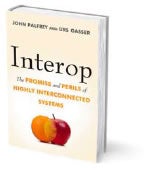
The highly connected nature of today’s world has all sorts of benefits—but all sorts of potential costs as well, from loss of control of private data to a world financial system so intertwined that when one part of it falls, it’s hard to keep other parts from toppling along with it. In “Interop: The Promise and Perils of Highly Interconnected Systems,” John Palfrey ’01 and Urs Gasser LL.M. ’03 draw on their work at the HLS Berkman Center for Internet & Society to start developing a “normative theory identifying what we want out of all this connectivity.” Gasser, executive director of the Berkman Center, and Palfrey, a former Berkman faculty director and HLS professor (now head of Phillips Academy Andover), spoke with the Bulletin about their book.
Bulletin: You write about interoperability—or interop—at work in everything from compatibility of different email programs to communication between different electrical grids to the linkages of European economies within the EU. How did you first approach this project?
John Palfrey: Urs and I came to the project with a very similar understanding of interoperability as a technical concept, one that has to do with making IT systems work together better. By the end, we came to see interop stories everywhere—it’s one of those sleeper topics where you are working on it from one angle and you start to see it in your everyday life in ways that are completely unexpected.
Urs Gasser: Working on this project has been an eye-opening experience, because it’s helped me see the many invisible links that connect the different systems I use every day—both personally and professionally. Understanding, let’s say, the complexity of a simple trip to Europe—I buy the ticket online, order a cab, go to the airport, board a plane, arrive safely in Zurich—leads to a new level of appreciation. You also start to see the potential points of failure.
Where does the field of law intersect with interop?
Palfrey: One way a law argument is at the core of this book is the extent to which law and interoperability are bidirectional.
Meaning that they can intersect in a couple of different ways?

Gasser: Yes. One example where you see bidirectionality at work is intellectual property law. Consider a manufacturer of cell phones and a producer of operating systems for cell phones—let’s say Nokia and Microsoft. They may decide to work together very closely. The way they legally form their collaboration is by licensing certain technologies to each other. And this kind of licensing may actually increase interoperability between the players. Now take another example. You see patent wars where it’s exactly about using IP assets or rights to prevent competitors from developing interoperable devices or applications—the same body of law can be used both in favor of interoperability and to hinder it.
How much attention is the U.S. government paying to this issue?

Palfrey: This is a hugely important policy matter in the United States, one that runs across many different topical areas. It’s also a very hard one; it’s an issue where one can see the tension between seeking to have highly interoperable technology systems that will drive innovation on the one hand and those who are concerned with international security and cybersecurity on the other. There are representatives from both sides of that argument, even within the White House. This question of how you get to an optimal level of interoperability is one on which many important topics will turn.
Is there anyone who says, “We don’t need a theory for this; interoperability is just going to happen, and businesses will work it out for themselves”?
Palfrey: There is an argument that the market sorts these kinds of matters effectively and there’s no need to be deliberate about it from a public policy perspective. I think there are a couple ways in which that argument is insufficient. One is, even when the market is determining levels of interoperability, a lot of design thinking has to go into that. And that design thinking is exactly what we’re calling for in the book, and it does have to be deliberate in order to ensure that broader goals than simply the self-interest of a given company are met. An example would be privacy and security in the computing context. I think we’ve seen consistently in social media in particular that companies that are serving individuals and doing so for free online don’t take privacy into account enough, and we need to be designing more for the long-term implications of giving away so much information about ourselves. That’s a crucial point that the market on its own doesn’t handle.

What sort of impact is the book having?
Gasser: The biggest compliment I’ve heard so far is that the book helps to structure the thinking about these issues. That’s one of the goals of the book: to advance a theory that is useful in practice—both in the executive boardroom and in the administration of governments. I’m hopeful that this theory can be refined and expanded over time. To me, the book is still very much a work in progress.
